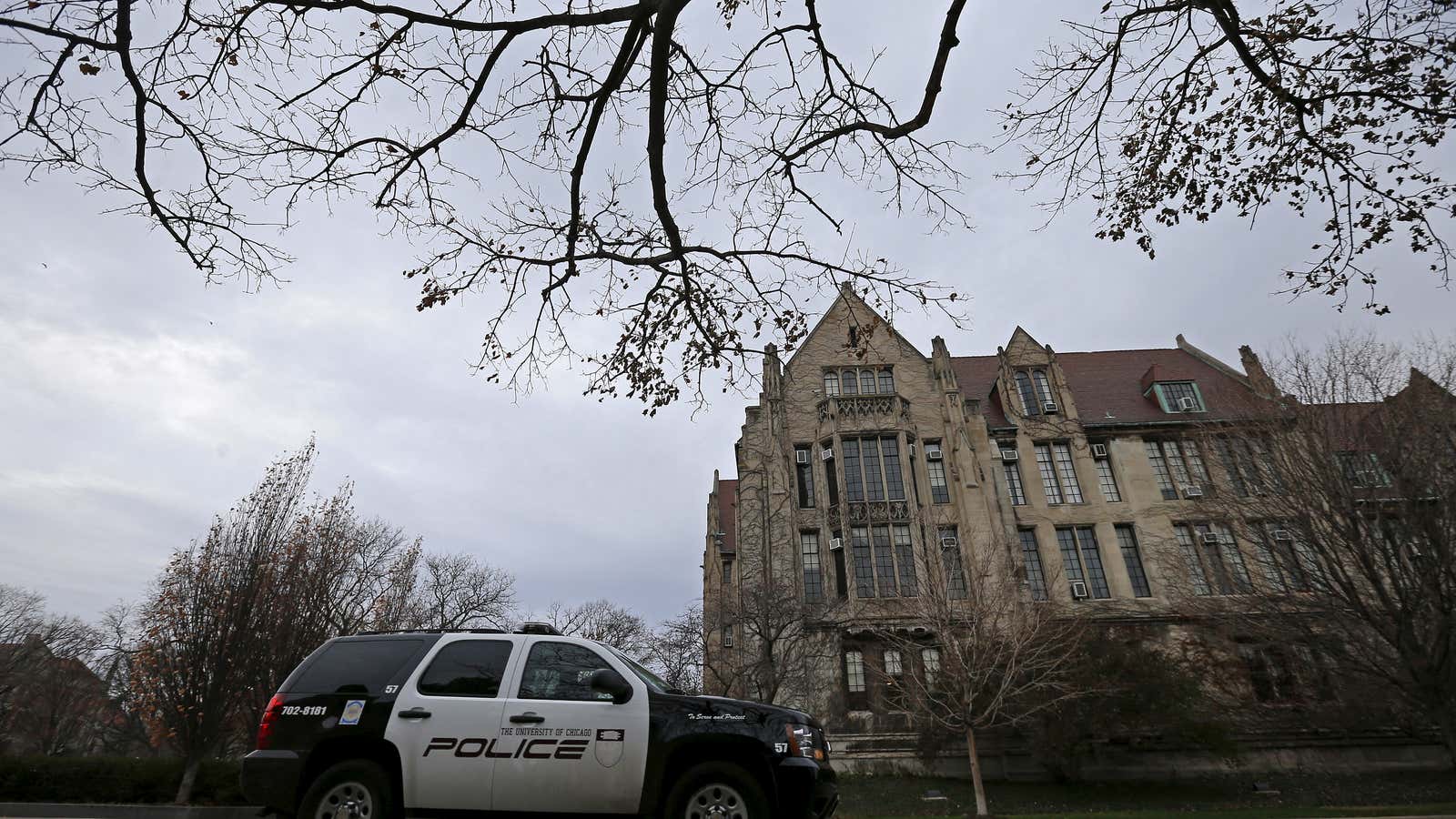“The members of our community must have the freedom to espouse and explore a wide range of ideas.”
So said John Ellison, dean of students at the University of Chicago, in a welcome letter sent to the incoming student body. The sentiment seems laudable enough. Who, after all, could object to the free exchange of ideas at a university? And yet the context of the letter refutes this logic. Ellison says he wants the community to “explore a wide range of ideas,” but the real purpose of the letter is to tell students that there are certain ideas that the university does not want them to discuss.
You might think that the chief danger to academic freedom would come from the government, or possibly from donor interference in hiring. Instead, though, Ellison sees the main danger to academic freedom as coming from “trigger warnings.” Trigger warnings in an academic context are notifications, often included on syllabi, that tell students that a reading or lecture will involve discussion of rape, violence, or other distressing material. Students who have experienced trauma, or who find such material upsetting, can then be prepared for it, choose other course offerings, or, in some cases, make other arrangements with professors.
Academic trigger warnings have been discussed at great length online, and I don’t want to repeat that discussion here. I have mixed feelings about their use, personally. But what’s striking about the University of Chicago dean’s letter is that, while it calls for freedom of expression, it peremptorily, and unilaterally, picks out a single topic—trigger warnings—and declares that this one issue is closed for debate.
Ellison’s letter is a polemic, but it’s also a utopian vision. The university, the letter insists, is an island—or, if you will, a safe space—in which all ideas are debated vigorously and safely, in which all have equal opportunity to present their ideas, and in which all are challenged and welcomed. “Diversity of opinion and background is a fundamental strength of our community,” Ellison declares, as if that diversity has already been accomplished, and requires no further work or questioning. It’s a bold claim for a university located on the south side of Chicago with black enrollment of less than 9%.
Whatever Ellison’s hopes or dreams, however, the fact remains that a university is not an egalitarian nirvana of inquiry. It’s a hierarchical institution that sets its own rules in terms of what can be said, as well as who is and is not invited to join the conversation.
And so, before they even arrive at school, University of Chicago students have been told they have no standing to disagree with Ellison on this issue. The letter puts students on notice that their thoughts and opinions about trigger warnings are not welcome; the university has made up its mind about this important intellectual issue of the day, and it is interested in neither compromise nor debate. Pro-trigger warning arguments are not analyzed or discussed; rather, trigger warnings are simply posited as the opposite of everything the university stands for, and dismissed on those grounds.
The letter doesn’t just target students either; it functions as an implicit instruction, and perhaps an admonition, to faculty. Presumably a tenured professor who wanted to use a trigger warning would feel comfortable doing so, but what about new hires or adjuncts? Will they be penalized if they use trigger warnings? Reprimanded? If the university hears that a professor is using a trigger warning, what will it do? Ellison does not say, but it seems clear that, at the very least, the administration would officially frown on a professor who flouts what certainly looks like an official school policy. A trigger warning is itself speech. When the university tells professors they shouldn’t use trigger warnings, it is restricting what they can say.
With that in mind, Ellison’s letter reads less as a defense of free speech and more as a blanket assertion of the administration’s power, and of its commitment to enforcing that power, regardless of student or community demands or interests. When Ellison says, “We do not cancel invited speakers because their topics might prove controversial,” that’s a (sort of) polite way of saying: You, as students, are not to protest against the invitation of certain speakers, and if you do your voices will be ignored. When he says, “Freedom of expression does not mean the freedom to harass or threaten others,” he’s reminding students that the university has the power to determine the limits of acceptable speech—and that it also has the power to punish those who violate the rules it sets down.
The university isn’t wrong to set down guidelines against harassment, even if in some cases those guidelines could be misused to target protestors. Rules governing speech are necessary in any community. Without them you quickly end up with a comments-section version of democracy in which the loudest, most offensive voices scream at each other endlessly, and everybody else falls silent and/or leaves.
This is exactly the argument made by proponents of trigger warnings. Simple rules about how difficult subjects are approached can make more people feel more welcome in the classroom. That means, proponents say, that a greater number of people can participate in debate and a greater number of views can be heard.
Ellison and trigger-warning proponents both want to create guidelines that allow for students to learn and explore. The difference is not that one side loves liberty and intellectual bravery and the other does not. The difference is that, in the name of free speech, one side has the institutional authority to shut down debate. That’s something Ellison could put in his next letter to students, if his administrative superiors let him.
